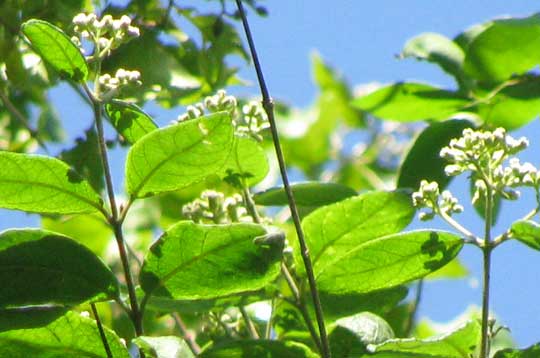Excerpts from Jim Conrad's
Naturalist Newsletter
from the January 31, 2010 Newsletter issued from Hacienda Chichen Resort beside Chichén Itzá Ruins, central Yucatán, MÉXICO; limestone bedrock, elevation ~39m (~128ft), ~N20.676°, ~W88.569°
COPAL NOT COPAL
A very conspicuous feature of Maya ceremonies is the plentiful use of copal incense. Copal is a natural plant resin usually mixed with some other medium such as wood shavings, and burnt, forming billowing white clouds of fragrant, white incense.
Maya rituals frequently are performed at Hacienda Chichen and lots of copal is used. I asked my friend Paulino if the copal-producing plant grows in this area and he replied that it does. One day when we were in the woods he led me to the plant and I was very surprised. For, the copal I knew was produced by trees, primarily the tree called Copal, Protium copal. In some places the dried exudate of the Gumbo-Limbo tree, Bursera simaruba, is used. Both of these trees belong to the Bursera Family, the Burseraceae. The Gumbo-Limbo is abundant here, but the tree called Copal grows farther south where it's rainier.
What Paulino showed me, however -- and he immediately set about plucking fragrant gobs of copal from the stem to prove his point -- was a thick-stemmed, woody vine like North America's larger grapevines. It's shown below:

In that picture, near my thumb, the powdery-white spot is where with my thumbnail I scraped away outer bark revealing tiny white globules of hardened, fragrant resin. That stem was absolutely saturated with resin. But, what plant was it?
Luckily, the vine now has flowered, though the flowers occur only at the top of the forest canopy. You can see my long-distance shot pushing PhotoShop to its limit below:

Again I'm amazed. The flowers are similar to those of Eupatorium -- composite flowers in the Composite or Daisy Family. But, who's ever heard of a woody, viny Composite that oozes super-fragrant, hardening resin?
The best I can tell, the mystery plant is OTOPAPPUS GUATEMALENSIS. That species isn't well documented on the Internet and I find no comment on its fragrant resin or its use by the Maya so maybe here I'm contributing information not hitherto published.
The copal used in Maya ceremonies at Hacienda Chichen is purchased in town. However, now I know that when the local backwoods Maya conduct their own ceremonies, for their copal they go deep into the forest seeking out this little-known Composite-Family woody vine.